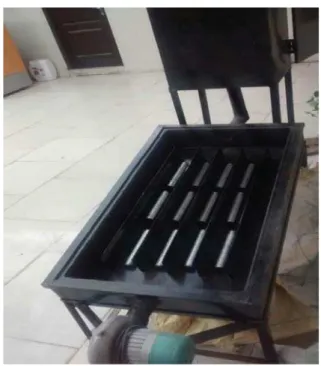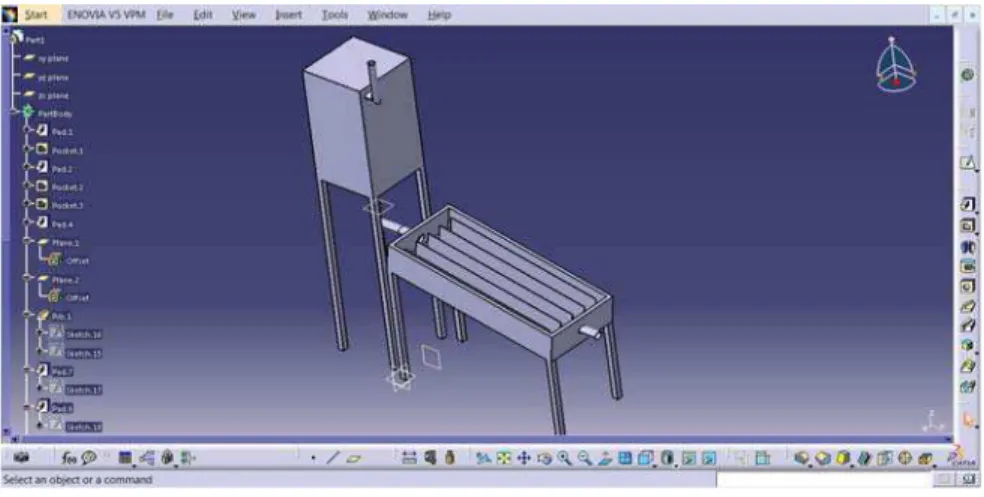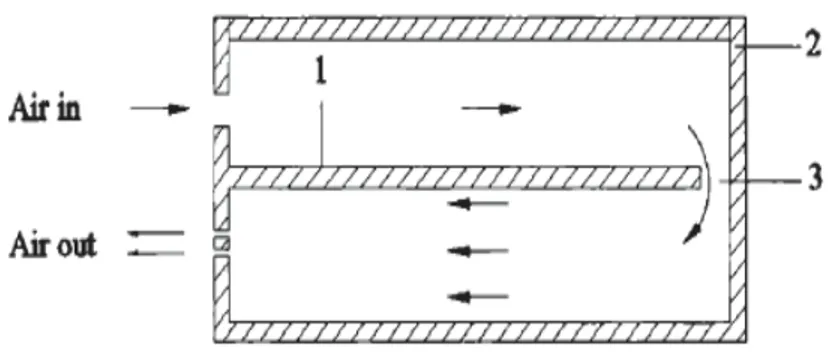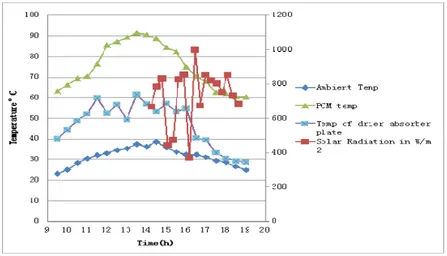Experimental Analysis on Forced Draft Solar
Dryer with Phase Change Material
Prashant Kumar
Department of Mechanical Engineering
Royal Institute Of Management and Technology (Maharishi Dayanand University), Rohtak, India
Abstract- Sun drying, which was traditionally used, has some drawbacks associated with it like poorer quality of goods contaminated by enzymes, microbes, insect attack and dust. Non- uniform and insufficient drying also leads to deterioration of crops during storage. In order to ensure continuous food supply to the growing population and to enable the farmer to produce high quality product to the market, efficient at the same time affordable drying methods are necessary which extend drying after sunset.
Hence, the aim of the project was to design a low cost solar dryer which performs drying operation even after sunset. The development and testing of this type of efficient solar dryer, particularly meant for drying vegetables and fruits, is described. The dryer has two compartments: one for collecting solar radiation and producing thermal energy and other for spreading the product to be dried. This arrangement was made to absorb maximum solar radiation by the absorber plate and to protect the product from direct exposure to solar radiation. The dryer was loaded with bitter gourd having an initial moisture content of 95% and the final desired moisture content of 5% was achieved within 6 hours without losing the product colour, while it was 11 hours for open sun drying.
An approach is also described in detail about the design and investigation on latent heat thermal energy storage system based on Phase Change Material (PCM). Acetamide (CH3CONH2) was used as PCM and it was filled in a specially fabricated stainless steel container having adequate heat transfer facility. The PCM container was integrated with the solar cabinet dryer to study the feasibility of energy storage for drying applications. A detailed study was undertaken with the PCM integrated into the dryer to know the drying performance. This was compared with open sun drying. In this work the dryer was loaded with ripe banana having an initial moisture content of 78%. Final (desired) moisture content of 15% was achieved within 12.5 hours, but the sample kept in the open sun drying could not reach its final desired moisture content in the same duration. It was found that the product loaded in the dryer, during night time, had a reduction in moisture content of 2.41% and the reduction in moisture during evening drying was 3.21%. The PCM integrated dryer, fabricated in the present work, could reduce the drying duration and maintained a warm atmosphere inside the dryer during night hours. This prevented the deterioration of the product even after sunset.
Keywords – Solar Dryer, PCM, Forced Draft Circulation, Acetamide
I. INTRODUCTION
Some industries related to tea, textiles, ceramics, milk powder, edible starch, baking powder, food, sugar, paper, raisins, pharmaceuticals etc. consumes large quantity of energy for drying processes. Though mechanical dryers have been introduced, increasing oil prices along with high investment and operational costs restrict their use in industry. Solar drying has been considered as one of the most promising drying processes for the utilization of solar energy. A properly designed solar dryer can alleviate the drawbacks associated with open sun drying and upgrade quality of the dried product. This in turn causes high returns to the producers [l-5].
the moisture. The fan provided in the system either pushes the air out or sucks air from the ambient to the drier. These dryers had the following drawbacks. The product cannot be made thicker because the solar radiation heats only the top thin layer. Further in some products, direct exposure to sunlight leads to discoloration and vitamin loss. Also, direct absorption of solar radiation by the product causes an unacceptable local temperature rise in the top thin layer of the product. An indirect type cabinet dryer with forced convection flow has been considered favorable since such a dryer is able to produce high quality product without discoloration with minimal drying duration. However, so far, indirect forced circulation solar cabinet dryers have not been reported in literature. The objective of the present work was to develop an efficient solar cabinet dryer, and to investigate its performance so as to optimize the design parameters. The feasibility of Phase Change Material (PCM) based latent heat thermal energy storage in solar drying was also brought under study.
II. PCM IN SOLAR DRYING
Latent heat thermal energy storage in phase change materials (PCMS) is considered as a developing energy technology, and there has been increasing interest in using this essential technique for thermal applications such as drying, hot water, air conditioning and so on. In a latent heat storage system, when a PCM is subjected to phase change process (melting or solidification) at an almost constant temperature, it absorbs or releases a quantity of heat as much as latent heat [12-14].
Amongst the various heat storage techniques, latent heat storage is particularly attractive due to its ability to provide a high energy storage density and to store heat at a constant temperature corresponding to the phase transition temperature of the heat storage substance. Much work has been reported using Phase Change Material (PCM) for solar thermal applications, particularly for cooking [15,16]. Experimental and theoretical efforts have been made to incorporate PCMs into flat plate collectors for storing solar energy by Bansal and Buddhi [17]. Some other researchers [18-22] analyzed the material properties of different types of PCMS under various conditions and their applications in solar energy storage. As stated earlier, study on incorporation of PCM storage with solar dryer is in its infancy and very few published works are there in the literature. Enibe [23] studied the performance of a natural circulation solar air heating system with phase change material energy storage for crop drying and egg incubation.
In that study, PCM was prepared in modules with the modules equispaced across the absorber plate. No work has been performed on forced circulation solar dryers with PCM thermal energy storage. In the present study, the feasibility of latent heat thermal energy storage in forced circulation solar dryer has been investigated. A PCM container was fabricated similar to a shell and tube heat exchanger. The fabricated container was placed in a solar cabinet dryer and studies were conducted with and without loading the product in the dryer. The charging and discharging of PCM has also been investigated.
III. EXPERIMENTAL SETUP
the absorber region was 10.5 cm, 31 cm, respectively. Two axial fans (20W each) were provided in one side to admit fresh air. Flow rate of each fan was 95 m3/h. Positions of the fans were at a height of 4 cm from the absorber plate. An air duct of area 0.0896 m2 was provided in the absorber to pass the hot air through the drying chamber. The location of the air duct was just opposite to the axial fan.
.All the trays were separated into two compartments each having 3 trays. The perforated trays were arranged at three different levels, one above the other. Aluminium ‘L’ angle was fitted all the comers of the tray to support it. Space between two consecutive trays was 10.2 cm. The diameter of the perforation was 6 mm and the distance between the holes was 70 mm. Two consecutive rows were separated by a distance of 2.5 cm and distance between the holes was 4 cm. The total area of the exhaust was 0.362m2
The diameter of the tube was 8 mm and its volume was 25.12 cm3 The tubes were positioned equidistant from each other with a distance of 4 cm between the tubes. The total area of the PCM container was 0.25 m2 with equal length and width of 0.50 m each. The total volume of the PCM container was 5250 cm3 and the filling area was 5054 cm} Tubes were positioned in centre of the container. Fig. 4.3 shows the schematic diagram of the PCM container. On the top surface of the tube a small pipe was fitted to fill the PCM into the container. Black selective coating was applied all over the container surface. Initial filling of PCM was done by melting it in a gas burner and then pouring it into the container.
Figure 2- CATIA image of Solar Dryer
IV. PHASE CHANGE MATERIAL (PCM) INVESTIGATION
Sharma et al. [16] reported that the PCM used for low temperature applications like water heating, baking and drying should have a melting / freezing cycle in the range of 45-90°C. Various materials suitable for energy storage in a temperature range of 50- l00°C have been reported in literature [18,24]. Commercial grade acetamide (CH3CONH2) was chosen as the PCM in the present work due to its low cost (Rs. 400/kg) and large-scale availability in the Indian market. The calculated melting temperature of acetamide was 76.56°C (reported 81°C in literature) and it favoured the application in drying since the recommended drying temperature required for most of the agricultural crops were around 60°C. Acetamide used in the present work was procured from Nice Chemicals Pvt. Ltd., India. Sharma et al. [19] conducted a detailed study on accelerated thermal cycle test of acetamide to investigate the changes in melting point, latent heat of fusion and the specific heat for 300 repeated melt/freeze cycles.
V. WORKING
Figure 3-Airflow passage in the solar dryer
V1. INVESTIGATION OF THE PERFORMANCE
The experiments were conducted in New Delhi. All the experiments were conducted from 9.30 a.m to 4.30 p.m and continued till 7.00 p.m, when the drier was integrated with PCM storage. Charging and discharging of PCM and its effect on solar drying was also carried out separately. Performance of the system was monitored for number of days. Details of the experiments, materials and methods for the performance evaluation are described below.
VII. EXPERIMENTAL PROCEDURE
The analysis was done on the drier with PCM storage. A brief description of the study is as follows:
Test with PCM
Here, the performance of the dryer was evaluated after placing PCM container in the dryer.
Test on dryer with PCM (Condition-1)
This study was aimed at analyzing charging / discharging behavior of PCM. Heat retention inside the dryer was studied when the axial fans in idle condition. Temperatures of the PCM, its container and outlet of the heat exchanger pipe were monitored along with other parameters described above. The experimental time period was from 9.30 a.m to 7.00 p.m.
Test on dryer with PCM, product loaded and axial fans in running condition (Condition-2)
In this test the dryer was loaded with 4 kg banana having initial moisture content of 78%. Banana was cut into 5 mm thick slices before loading in the dryer. The product was equally loaded in all the six trays uniformly. The experiment was conducted from 9.30 a.m to 7.00 p.m when the dryer was integrated with PCM storage. The experimental period was from 9.30 a.m to 4.30 p.m when it was done without PCM storage.
A.Condition -1
resistance to the flow of heat increases during the heat extraction process. Fig. 5.3 shows the temperature profile on the day. The experiment was performed to determine the maximum temperature of PCM when it was filled in a black selective coated container and placed in the absorber plate of the dryer. The PCM container was also exposed to solar radiation and there was no forced movement of air over the PCM container. The maximum temperature of PCM recorded in the set up was 9l.8°C, which was 15.2°C higher than melting point. The maximum temperatures of the PCM container and outlet of the heat exchanger pipe were, l03.7°C and 95.l°C, respectively. But the absorber plate temperature was 6l.2°C, which was very less compared to the earlier study. The appreciable reduction in the absorber plate temperature was due to the high heat transfer from the plate to the PCM through the container. The recorded maximum temperature of the PCM was an indication of the occurring of phase change, as the measured melting point of acetamide is 76.6°C. The experiment was continued till 7.00 p.m in the night and the temperatures of PCM, container and heat exchanger pipe were, 58.6°C, 55.8°C, and 59.4°C, respectively. The reduction of temperatures was in a very slow mode. While the absorber plate temperature reduced to 39.2°C. Ambient temperature varied from 30.3°C to 33.9°C during 9.30 a.m to 7.00 p.m.
Figure 4. Temperature profile of the PCM integrated solar dryer without forced circulation of air
B.Condition -2
The experiment was conducted on two consecutive days with 4 kg ripe banana loaded in the dryer. The PCM container was placed on the absorber near the air duct. Variations of temperatures of the PCM and dryer on the first day of operation are shown in Fig. 5.4. The maximum temperature attained by the PCM was 88.8°C while it was 91.8°C when the fan was in idle condition. It was observed that the difference in maximum temperature of PCM was comparable under natural and forced convection. It was due to the low airflow rate of the fan; in this condition, the conductive heat transfer from plate to PCM container was predominant than the convective heat transfer from plate to flowing air. The airflow rate was maintained at 0.11 kg/s. .
non-solar hours was 5.62%. Apart from the small reduction of moisture content during the night hours, the provision of PCM produced a warm environment in the solar dryer. It helps for not only reducing the moisture content but also prevent deterioration of the product even though the solar radiation intensity is abysmal. A study was also performed by keeping the sample in the open sun to compare the drying performance with solar dryer. The moisture content measured at the end of first day of operation, with an effective drying duration of 7 hours, was 30.87%, while that of the sample loaded in the solar dryer was 24.18%. The experiment was continued on the next day with the open dried sample and the value of moisture content after 14 hours of operation was 18.23%. This showed that the final desired moisture content could not be achieved even after 2 days of operation [with an effective drying duration of 14 hours] as the sample was dried in open sun.
Variation of dryer and PCM temperatures with product loaded in the dryer
VIII.Conclusion
An efficient solar cabinet dryer was designed, fabricated and its performance was analyzed. The product was loaded beneath the absorber plate and not exposed to direct sunshine. This retained original colour of the product. Since the drying took place in a closed chamber, the product was protected from insects and dust. Hence it is possible to get good quality product from the dryer. The axial fans provided in the dryer accelerated the drying process.The cost of drying bitter gourd in the solar dryer was 42% less than that of an electric dryer. The life of the system was expected to be 20 years, because it had no corrosive material. The designed dryer was integrated with a Phase Change Material to extend the use of dryer in the evening/night hours. The study revealed that there was a 5.62% reduction of moisture due to the incorporation of storage material during evening/night. The drying experiment conducted with banana and it was found that the complete drying process could be attained with 12.5 hours, which was much less than that of open sun drying. It was also established that acetarnide is a promising PCM in solar drying applications. The developed system is well adaptable to perishable crops and some sensitive products, which require continuous drying. Hence the arrangement would help to reduce the usage of other conventional energy sources/back up used to meet energy requirement during non-sunshine hours to some extent.
REFERENCES
[1] BP, BP Statistical Review of World Energy, 2007, http://www.bp.com/ statistical review.. [2] W. B. J.A. Duffie, Solar Engineering of Thermal.
[3] J. Gordon, Solar Energy- The State of the Art, ISES Position Papers, UK: James & James (Science Publishers) Ltd., 2005. [4] G. Tiwari, Solar Energy: Fundamentals, Design, Modelling and Applications.
[7] B. Magal, , Solar Power Engineering.
[8] "Indian Standard 12933 (part 2), Bureau of Indian Standards, Solar Flat -plate collector-Specifications, Part 2- Components, 1992.". [9] H. Garg, Advances in Solar Energy Technology.
[10] N. B. A. k. P. B. a. M. M. M.S. Sodha, Solar Crop Drying.
[11] T. K. a. S. K. S.C. Mullick, "Thermal test procedure for a paraboloid concentrator solar cooker". [12] H. G. a. J. Prakash, Solar Energy: Fundamentals and.
[13] 1. K. Altfeld and W Leiner 127-132, ", Second law optimization of flat plate solar air heaters,," Solar Energy 41,, 127-132, 1998.. [14] A. Whillier, "Performance of black-painted solar air heaters of conventional design," Solar Energy 8(1), 31-37, 1964..
[15] H. G. a. R. A. P. o. a. s. a. h. c. d. a. p. I. s. J. o. t. S. E. S. o. I. 7. 1. A.R. Shukla.
[16] H. G. a. V. S. A.K. Bhargava, " Evaluation of the performance of air heaters of conventional designs,," Solar Energy 29(6). 523-533, 1982..
[17] S. Satcunanathan and S. Deonarine, " A two-pass solar air heater,," Solar Energy 15, 41-49, 1973. [18] C. G. a. H. Garg, " Performance studies on solar air heaters," Solar Energy 11(5), 25-31, 1967. [19] W. Kays, , Convective heat and mass transfer,.
[20] S. R. H. a. O. Morck, Solar Air Systems: A Design Handbook. [21] "K. Lutz and W. Muhlbauer, Drying Technology 4, 583, 1986.".
[22] M. Beedie, " Energy savings-a question of quality," South African Journal of Food Science and Technology , Vols. 48(30), 14-16, 1995..



